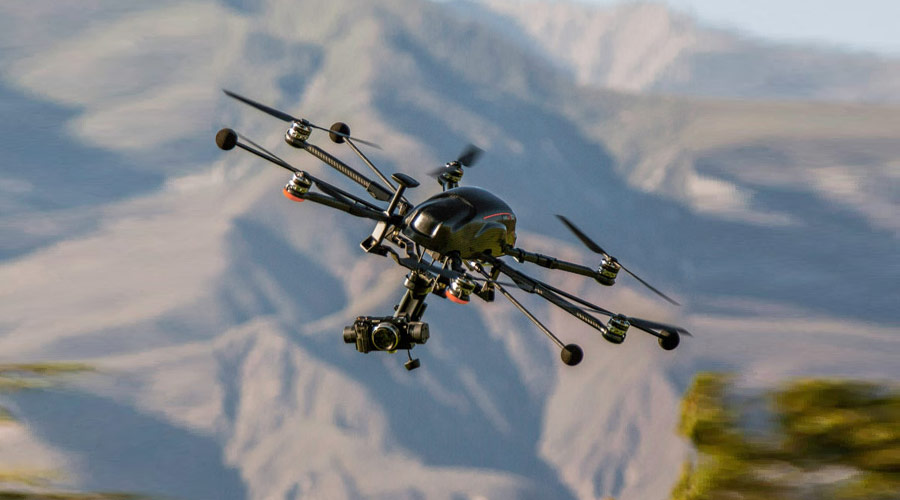
Robohub.org
The Drone Center’s Weekly Roundup: 8/31/15

A Yuneec H920 drone. Credit: Yuneec Holding Ltd.
The U.S. National Guard operates a substantial—and strategically critical—fleet of Predator and Reaper drones in America’s wars. Now, the service is taking steps to bring those drones home for use in emergency response and law enforcement. We explore the history of the National Guard’s drone programs, its plans for domestic drone operations, and the hurdles that those plans face.
A U.S. drone strike reportedly killed a high-level member of the Islamic State. Junaid Hussain, a British citizen, was a prominent online recruiter and hacker within the organization. According to unnamed U.S. officials who spoke with the Wall Street Journal, Hussain was killed in a strike outside of the Syrian city of Raqqa.
Intel Corporation will invest more than $60 million in Yuneec Holding Ltd., a Hong Kong-based company that manufactures consumer drones. “We’ve got drones on our road map that are going to truly change the world and revolutionize the industry,” Intel CEO Brian Krzanich said in a video presentation on the company’s website. (Wall Street Journal)
The Federal Aviation Administration released a mobile phone app to help drone users understand the airspace in which they are operating. The “B4UFLY” app, which gives users the ability to plan flights and access airspace maps, is part of an ongoing campaign to educate new drone users about airspace safety. (Press Release)
The California State Legislature passed a bill that would restrict drone flights. Senate Bill 142, which was introduced by state Sen. Hannah-Beth Jackson, would require drone operators to receive permission from property owners for overflights below 350 ft. The bill now requires the governor’s signature before becoming law. (USA Today)
A drone operator in Los Angeles was arrested after flying close to a Los Angeles Police Department helicopter. The drone reportedly came within 50 ft. of the helicopter, forcing the pilot to take evasive maneuvers. The drone operator, whose name has not been released, was taken into custody for interfering with police activity and will be questioned by the FAA. (ABC7) For more on close calls between drones and aircraft, click here.
Meanwhile, two American drone operators were fined $1,025 for allegedly flying within 30 ft. of a pod of orca whales near Vancouver Island. The fines were issued by the Washington Department of Fish and Wildlife. “We take it very seriously. These orcas are key to the local economy,” Sgt. Russ Mullins of Fish and Wildlife said in an interview with KIRO 7 TV.
Law enforcement authorities in Maryland announced that two men were arrested for trying to smuggle contraband into a prison using a drone. In a pickup parked outside of the Western Correctional Institution in Cumberland, officers discovered a multi-rotor drone helicopter along with tobacco, drugs, and pornography. Although similar drone smuggling attempts have been made in other states, it was the first known incident of the kind in Maryland. (The Baltimore Sun)
Commentary, Analysis, and Art
At the Daily Beast, Justin Glawe writes that a bill passed by the North Dakota state legislature in April gives police the authority to arm drones with non-lethal weapons like tear gas. For more on police drones, click here and here.
At Popular Science, Kelsey D. Atherton writes that police regulations in North Dakota prohibit arming drones with any kind of weapon.
At Just Security, Rachel Levinson-Waldman argues that cities and states must address the complexities of introducing new surveillance tools like police drones and body cameras.
At The Verge, Arthur Holland Michel writes that aspiring drone operators are learning how to fly hot air balloons in order to meet the FAA’s requirements for commercial drone exemptions.
At Defense One, Marcus Weisgerber considers whether a single service should run the U.S. military’s drone programs.
Also at Defense One, Patrick Tucker takes a look at a variety of anti-drone measures, writing that the viability of geo-fencing is “somewhat wishful thinking.”
At the Strategic Studies Institute, Dr. Robert J. Bunker investigates the threats posed by terrorist and insurgent organizations that are equipped with drones.
At Slate, Lily Hay Newman considers whether drones should be equipped with some kind of identification mechanism.
In an advertisement for its systems, PRENAV, a company that specializes in automating flight paths for drones, creates intricate light shows with multicopters. (Vimeo)
At the New York Times Magazine, Scott Shane explains why Anwar al-Awlaki, a Yemeni-American who was killed in a U.S. drone strike in 2011, remains influential.
Sen. Bernie Sanders, a candidate in the Democratic primary race for president, discussed the targeted killing program on ABC’s “This Week with George Stephanopoulos.” (The Hill)
Meanwhile, Republican primary candidate Ben Carson suggested that if he were elected president, he might use drones to a greater extent on the U.S. border with Mexico. (CNN)
At Inc.com, Tess Townsend surveys the responses from the drone business community to California’s legislation that would ban low-flying drone operations.
At U.S. News, Ben Lerner argues that the nuclear accord between the United States and Iran will allow Iran to advance its drone program.
At Reuters, Victoria Bryan and Peter Maushagen take a look at efforts in the European Union to reduce to risk posed by drones to manned aircraft.
Know Your Drone
Technology company Sony has released a video of a prototype of its new fixed-wing drone, which can take off vertically and fly at over 100 mph. (CNET)
A team of researchers at Stanford have discovered how whooper geese are able to keep their heads steady during flight; these findings could be used to develop mechanisms for more stable drone cameras. (Stanford Press Release)
The U.S. Defense Advanced Research Projects Agency has launched a program, called Gremlins, to develop small swarming drones that can be deployed by other aircraft. For more on drone swarms, clickhere.
Torquing, a British company, will begin shipping its Zano micro-drone, which was funded by Europe’s most successful Kickstarter campaign, even though the drone still has unresolved software issues. (BBC)
A German startup has unveiled a system that uses various sensors to detect and track small drones at a range of about 300 ft. (Discovery)
Boeing demonstrated a portable version of its HEL anti-aircraft laser, which could be used to bring down small drones. (Wired)
Russian defense contractor KRET has unveiled a model of a low-observable military drone that could be used to hunt enemy stealth aircraft such as the U.S. F-35. (Flight Global)
Forbes’ Aaron Tilley looks at the efforts of two chip makers, Intel and Qualcomm, to develop computer vision systems that could be used on drones.
China’s military has released a video of its newest armed drone, the CASC Rainbow 5, on state television. The Rainbow 5 is said to have a similar wingspan to the U.S. Reaper, and is reportedly capable of carrying six missiles. (South China Morning Post)
The U.S. Navy conducted an experiment in which it launched two kinds of small reconnaissance drone from one of its Joint High Speed Vessel warships. (USNI News)
Drones at Work
NASA has deployed its Global Hawk high-altitude surveillance drone to track weather events during this year’s hurricane season. (NASA Press Release)
In Sacramento, California, a drone is being used to monitor progress on the construction of a new stadium and identify areas where workers are falling behind schedule. (MIT Technology Review)
Peruvian officials from the Ministry of Culture are using drones to create 3D maps of Machu Picchu and other historical sites. (Slate)
Several schools are offering advanced degrees in drone engineering and flight operation. (Fortune)
The U.S. Park Service used a ScanEagle drone to help firefighters battling the Paradise Fire in Washington State’s Olympic National Park. (The Seattle Times)
A drone was used to capture footage of the anti-garbage protests in Beirut. (MarketWatch)
A drone disturbed a Benedictine monk sunbathing atop of a 24 ft. wind turbine in Rhode Island. (TIME)
The Weekly Drone Roundup is a newsletter from the Center for the Study of the Drone. It covers news, commentary, analysis and technology from the drone world. You can subscribe to the Roundup here.
tags: c-Aerial, drones, UAVs




